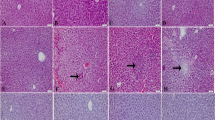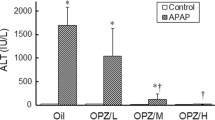Abstract
Acetaminophen has a reasonable safety profile when consumed in therapeutic doses. However, it could induce hepatotoxicity and even acute liver failure when taken at an overdose. Pioglitazone, PPARγ ligand, is clinically tested and used in treatment of diabetes. PPARγ is a key nuclear hormone receptor of lipid metabolisms and regulates several gene transcriptions associated with differentiation, growth arrest, and apoptosis. The aim of our study was to evaluate the hepatoprotective activity of pioglitazone on acetaminophen-induced hepatotoxicity and to understand the relationship between the PPARγ and acetaminophen-induced hepato injury. For the experiment, Sprague–Dawley rats (160–180 g) were used and divided into four groups. Groups I and II were normal and experimental controls, respectively. Groups III and IV received the pioglitazone 20 mg/kg for 10 days. Hepatotoxicity was induced in Groups II and III on the eighth day with acetaminophen (i.p. 350 mg/kg body weight). The hepatoprotective effect was evaluated by performing an assay of the total protein, total bilirubin, alkaline phosphatase, aspartate aminotransferase, alanine aminotransferase, and α-fetoprotein as well as glutathione peroxidase, lipid peroxidation, catalase, superoxide dismutase, and glutathione transferase and liver histopathology. The assay results were presented as mean and standard error of mean for each group. The study group was compared with the control group by one-way ANOVA test. A p value of <0.05 was considered significant. Pioglitazone significantly reduced the elevated level of above serum marker enzymes and also inhibits the free radical formation by scavenging hydroxyl ions. It also restored the level of LPO and significantly elevated the levels of endogenous antioxidant enzymes in acetaminophen-challenged hepatotoxicity. Liver histopathological examination showed that pioglitazone administration antagonized acetaminophen -induced liver pathological damage. Various biochemical estimations of different hepatic markers and antioxidant enzymes and histopathological studies of liver tissues glimpse a support to its significant hepatoprotective activity on acetaminophen -induced hepatotoxicity.

Similar content being viewed by others
References
Bonkovsky HL, Kane RE, Jones DP, Galinsky RE, Banner B (1994) Acute hepatic and renal toxicity from low doses of acetaminophen in the absence of alcohol abuse or malnutrition: evidence for increased susceptibility to drug toxicity due to cardiopulmonary and renal insufficiency. Hepatology 19(5):1141–1148
James LP, Mayeux PR, Hinson JA (2003) Acetaminophen-induced hepatotoxicity. Drug Metab Dispos 31(12):1499–1506
Jaeschke H, Bajt ML (2006) Intracellular signaling mechanisms of acetaminophen-induced liver cell death. Toxicol Sci 89(1):31–41
Girish C, Koner BC, Jayanthi S, Ramachandra Rao K, Rajesh B, Pradhan SC (2009) Hepatoprotective activity of picroliv, curcumin and ellagic acid compared to silymarin on paracetamol induced liver toxicity in mice. Fundam Clin Pharmacol 23:735–745
Nagi MN, Almakki HA, Sayed-Ahmed MM, Al-Bekairi AM (2010) Thymoquinone supplementation reverses acetaminophen-induced oxidative stress, nitric oxide production and energy decline in mice liver. Food Chem Toxicol 48:2361–2365
Oz HS, Chen TS (2008) Green-tea polyphenols down regulate cyclooxygenase and Bcl-2 activity in acetaminophen-induced hepatotoxicity. Dig Dis Sci 53:2980–2988
Yan SL, Wu ST, Yin MC, Chen HT, Chen HC (2009) Protective effects from carnosine and histidine on acetaminophen-induced liver injury. J Food Sci 74:H259–H265
Michalik L, Desvergne B, Wahli W (2004) Peroxisome-proliferator-activated receptors and cancers: complex stories. Nat Rev Cancer 4:61–70
Rosen ED, Spiegelman BM (2001) PPAR gamma: a nuclear regulator of metabolism, differentiation, and cell growth. J Biol Chem 276:37731–37734
Borbath I, Horsmans Y (2008) The role of PPAR gamma in hepatocellular carcinoma. PPAR Res 2008:209520
Lambe KG, Tugwood JD (1996) A human peroxisome-proliferator activated receptor-gamma is activated by inducers of adipogenesis, including thiazolidinedione drugs. Eur J Biochem 239:1–7
Chang TH, Szabo E (2000) Induction of differentiation and apoptosis by ligands of peroxisome proliferator-activated receptor γ in non-small cell lung cancer. Cancer Res 60:1129–1138
Kudo H, Yata Y, Takahara T, Kawai K, Nakayama Y, Kanayama M, Oya T, Morita S, Sasahara M, Mann DA, Sugiyama T (2009) Telmisartan attenuates progression of steatohepatitis in mice: role of hepatic macrophage infiltration and effects on adipose tissue. Liver Int. 29:988–996
Premalatha B, Sachdanandam P (1999) Effect of Semecarpus anacardium nut milk extract on rat serum alpha-feto protein level in aflatoxin B mediated hepatocellular carcinoma. Fitoterapia 70:279–283
Ohkawa H, Ohishi N, Yagi K (1979) Assay for lipid peroxides in animal tissues by thiobarbituric acid reaction [J]. Anal Biochem 95:351–358
Marklund S, Marklund G (1974) Involvement of superoxide anion radical in the autoxidation of pyrogallol and a convenient assay for superoxide dismutase. Eur J Biochem 47:469–474
Sinha AK (1972) Colorimetric assay of catalase. Anal Biochem 47:389–394
Yeo W, Mo FK, Koh J, Chan AT, Leung T, Hui P (2006) Quality of life is predictive of survival in patients with unresectable hepatocellular carcinoma. Ann Oncol 17:1083–1089
Borges LP, Borges VC, Moro AV, Nogueira CW, Rocha JB, Zeni G (2005) Protective effect of diphenyl diselenide on acute liver damage induced by 2-nitropropane in rats. Toxicology 210:1–8
Klaunig JE, Kamendulis LM (2004) The role of oxidative stress in carcinogenesis. Ann Rev Pharmacol Toxicol 44:239–267
Esterbauer H, Chesseman KH (1990) Determination of aldehydic lipid peroxidation products: malonaldehyde and 4-hydroxy-nonenal. Meth Enzymol 186:407–421
Hietanen E, Ahotupa M, Bartsch H (1987) In Carcinogenesis and Tumor Progression. In: Lapis K, Kcharst S (eds) Lipid peroxidation and chemically induced cancer in rats fed lipid rich diet, vol 4. Akademiaikiado, Budapest, pp 9–16
Robak J, Glyglewsi RJ (1988) Flavonoids are scavengers of superoxide anions. Biochem Pharmacol 37:837–841
Hayes JD, Flanagan JU, Jowsey IR (2005) Glutathione transferases. Ann Rev Pharmacol Toxicol 45:51–88
Kuruta M, Suzuki M, Agar NS (1993) Antioxidant systems and erythrocyte life span in mammals. Biochem physiol 106:477–487
Li MY, Kong AW, Yuan H, Ma LT, Hsin MK, Wan IY, Underwood MJ, Chen GG (2012) Pioglitazone prevents smoking carcinogen-induced lung tumor development in mice. Curr Cancer Drug Targets 12(6):597–606
Wang Y, James M, Wen W, Lu Y, Szabo E, Lubet RA (2010) Chemopreventive effects of pioglitazone on chemically induced lung carcinogenesis in mice. Mol Cancer Ther 9(11):3074–3082
Author information
Authors and Affiliations
Corresponding author
Rights and permissions
About this article
Cite this article
Gupta, G., Krishna, G., Chellappan, D.K. et al. Protective effect of pioglitazone, a PPARγ agonist against acetaminophen-induced hepatotoxicity in rats. Mol Cell Biochem 393, 223–228 (2014). https://doi.org/10.1007/s11010-014-2064-9
Received:
Accepted:
Published:
Issue Date:
DOI: https://doi.org/10.1007/s11010-014-2064-9




